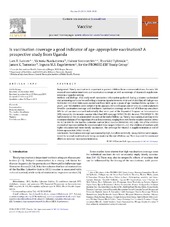Is vaccination coverage a good indicator of age-appropriate vaccination? A prospective study from Uganda
Fadnes, Lars Thore; Nankabirwa, Victoria; Sommerfelt, Halvor; Tylleskär, Thorkild; Tumwine, James K.; Engebretsen, Ingunn Marie S.
Peer reviewed, Journal article
Published version
Permanent lenke
https://hdl.handle.net/1956/9804Utgivelsesdato
2011-04-27Metadata
Vis full innførselSamlinger
Originalversjon
https://doi.org/10.1016/j.vaccine.2011.02.093Sammendrag
Background: Timely vaccination is important to protect children from common infectious diseases. We assessed vaccination timeliness and vaccination coverage as well as coverage of vitamin A supplementation in a Ugandan setting. Methods and findings: This study used vaccination information gathered during a cluster-randomized trial promoting exclusive breastfeeding in Eastern Uganda between 2006 and 2008 (ClinicalTrials.gov no. NCT00397150). Five visits were carried out from birth up to 2 years of age (median follow-up time 1.5 years), and 765 children were included in the analysis. We used Kaplan–Meier time-to-event analysis to describe vaccination coverage and timeliness. Vaccination coverage at the end of follow-up was above 90% for all vaccines assessed individually that were part of the Expanded Program on Immunization (EPI), except for the measles vaccine which had 80% coverage (95%CI 76–83). In total, 75% (95%CI 71–79) had received all the recommended vaccines at the end of follow-up. Timely vaccination according to the recommendations of the Ugandan EPI was less common, ranging from 56% for the measles vaccine (95%CI 54–57) to 89% for the Bacillus Calmette–Guérin (BCG) vaccine (95%CI 86–91). Only 18% of the children received all vaccines within the recommended time ranges (95%CI 15–22). The children of mothers with higher education had more timely vaccination. The coverage for vitamin A supplementation at end of follow-up was 84% (95%CI 81–87). Conclusions: Vaccination coverage was reasonably high, but often not timely. Many children were unprotected for several months despite being vaccinated at the end of follow-up. There is a need for continued efforts to optimise vaccination timeliness.
Utgiver
ElsevierTidsskrift
VaccineOpphavsrett
Copyright 2011 Elsevier Ltd.
Med mindre annet er angitt, så er denne innførselen lisensiert som Attribution-NonCommercial-NoDerivs CC BY-NC-ND
Beslektede innførsler
Viser innførsler beslektet ved tittel, forfatter og emneord.
-
Cost-Effectiveness of Vaccination of Older Adults with an MF59®-Adjuvanted Quadrivalent Influenza Vaccine Compared to Standard-Dose and High-Dose Vaccines in Denmark, Norway, and Sweden
Jacob, Jorge; Biering-Sørensen, Tor; Holger Ehlers, Lars; Edwards, Christina Hansen; Mohn, Kristin Greve-Isdahl; Nilsson, Anna; Hjelmgren, Jonas; Ma, Wenkang; Sharma, Yuvraj; Ciglia, Emanuele; Mould-Quevedo, Joaquin (Journal article; Peer reviewed, 2023)Individuals aged 65 years and above are at increased risk of complications and death from influenza compared with any other age group. Enhanced vaccines, as the MF59®-adjuvanted quadrivalent influenza vaccine (aQIV) and ... -
Influenza Vaccination Strategies: Comparing Inactivated and Live Attenuated Influenza Vaccines
Sridhar, Saranya; Brokstad, Karl Albert; Cox, Rebecca Jane (Peer reviewed; Journal article, 2015-04-24)Influenza is a major respiratory pathogen causing annual outbreaks and occasional pandemics. Influenza vaccination is the major method of prophylaxis. Currently annual influenza vaccination is recommended for groups at ... -
Live Attenuated Influenza Vaccine (LAIV) Immunization in Children and Adults: Lesson for Development of Universal Influenza Vaccine
Islam, Shahinul (Doctoral thesis, 2019-11-06)According to the WHO (World Health Organization), one billion peoples are infected annually of whom three to five millions become severely ill and 250-500 000 deaths worldwide (He, Wang et al. 2013) although the latest ...

